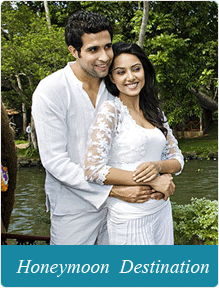
Testimonials
Ajay Prinja,
L'Oreal India
Haim Horey,
Mosav Netaim Israel
News & Events
Fairs & Festivals in India
Fairs & festivals in India are colorful commemorations of religious or historical events or celebrations of the change of seasons. They reflect the vigor & life style of its people. Vibrant colors, music & festivities make the country come alive throughout the year. The Fairs decorate the fine fabric of rich culture and tradition and Festivals celebrated in India with lots of zest and joy.
Pushkar Festival
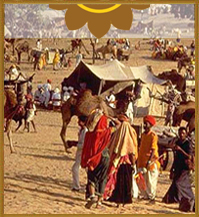
Pushkar fair is celebrated during the month of November. The holy city Ajmer is known for being home to the only temple of Brahma and for the Pushkar Fair.
Celebrated on the occasion of Karthik Purnima (November), it is believed that Lord Brahma, Vishnu and others come down to Pushkar to bath in the lake Pushkar. So it is considered very holy to bath in the Pushkar Lake on this auspicious occasion.
Trading of cattle, camel races & dazzling displays of bangles, brassware, clothes, camel saddles & halters are the major attractions of this colorful event which lasts for twelve days.

Holi Festival – A Riot of Colour
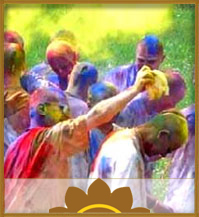
Holi - sometimes called the festival of colors or Phalgunotsava - is the Hindu festival of the spring equinox. It is celebrated throughout India for two days during the full moon of the month Phalguna, which is in February-March. Holi is dedicated to Krishna in north India and Kama in the south.
Holi heralds the end of the winter and the beginning of the spring and marks the rekindling of the spirit of life. It is a festival of joy when all is forgiven. People throw coloured powder at each other and make merry. Singing and dancing add to the gaiety of the occasion.
Holi celebrations in Mathura and the small towns of Braj Bhoomi, the land of Sri Krishna, are spectacular.

Khajuraho Dance Festival
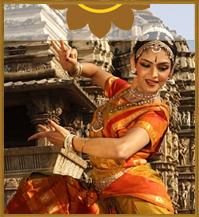
Every year from 25th February to 2nd March, Khajuraho Dance Festival takes place at the open-air auditorium in front of the Chitragupta Temple dedicated to the Sun God and the Vishwanatha Temple dedicated to lord Shiva's . outlandish classical dance performances presented in a dreamlike setting of splendidly illuminated temples.
Khajuraho temples present sculptures depicting various skills and arts of courtly love including dance and music in stone and what venue can be more befitting to hold the cultural festival highlighting the various classical dances of India.
Some of the best artists and performers that have marked themselves in their fields come from the various states of India to participate in the festival and the performances including some of the best known dance styles such as the intricate footwork of Kathak, highly stylized and sophisticated Bharathanatyam, soft lyrical temple dance of Odissi, the dance dramas of Kuchipudi, Manipuri, the dance of rare and ancient civilization and Kathakali stage fights with elaborate masks.

Ladakh Festival
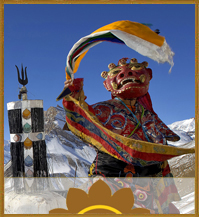
Ladakh festival is a major event organized every year from 1st to 15th September by the J&K Tourism. Its main objective is to revive and promote the richness, depth and pageantry of Ladakh's centuries-old culture, traditions and folk heritage for worldwide appreciation and enjoyment. At the Polo ground, where the procession terminates, the participants break into a variety of folk and popular dances, presenting the best samples of the region's performing arts.
A major polo tournament called the "Ladakh Festival Cup" is also held as part of the festival in which polo teams from different parts of the region participate. Yet another interesting programme is the staging of a typical Central Asian trade mart in Leh Bazaar, complete with caravans laden with traders' goods, while skilled artists dressed in period-costumes play the role of merchants engaged in trading, bartering and associated activities. Programs are also held in Zanskar Valley, where the high point is the traditional sport called "Saka", in which a number of colorfully attired horses are used in a quaint racing competition.

Kullu Festival
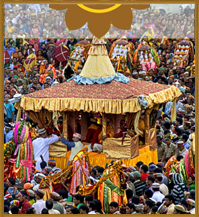
Kullu Dusshera is celebrated in the month of October, In Himachal Pradesh, a week long fair in the hill town of Kullu, is part of the Dussehra celebrations. From the little temples in the hills, deities are brought in procession to the 'maidan' in Kullu, to pay homage to the reigning deity, Raghunathji. The celebration actually begins nearly 10 days in advance as per tradition.
The annual mela or festival takes place in the Kullu valley – also known as Valley of the living Gods, in north India. The festival celebrates the triumph of the god Ram over evil. Dusshera at kullu commences on the tenth day of the rising moon, i.e. on ' Vijay Dashmi ' day itself and continues in seven days.
The birth of Dusshera in Kullu lay in royal fads and it nourished on religious, social, & economic factors & ultimately came to be well established, because of the inborn love hill – men for fun, frolic, displayed in community singing & dancing.

Goa Festival
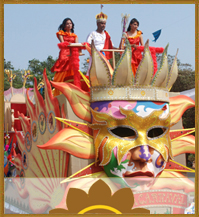
Goa has a unique blend of socio-religious culture. Being a predominantly Roman Catholic society, there are more Christian festivals in Goa. The Goanese calendar is marked by several feast days. Celebrated throughout Goa, and finishing two days before the season of Lent that precedes Easter, the Carnival (or Carnival) in Goa is a non-stop 3-day festival of color, song and music, providing a healthy entertainment for all, young and old.
The Carnival in Goa is an integral part of the Portuguese heritage of the state. It was introduced by the erstwhile rulers as a rowdy celebration in which flour, eggs, oranges, lemons, mud, sand-filled gloves along with dirty water, various liquids and glue were aimed at passersby. Used pots, pans, and other kitchen utensils were also thrown out of windows. Perhaps this was done to discard the old and the dirty before the Lenten fast. Fierce battles were waged in the streets, with plaster-of-Paris eggs, wax lemons, corncobs and beans. Blows were dealt out liberally, with brooms and wooden spoons.
It was also an occasion when people gorged on rich food at lavish feasts, and convents distributed cakes and pastries. Though celebrated for only three days, the preparations for the festival take days, and builds up a frenetic pitch by the eve of the carnival. The carnival is not celebrated anywhere else in India and was in decline even in Goa in the last few years of Portuguese rule.

Desert Festival
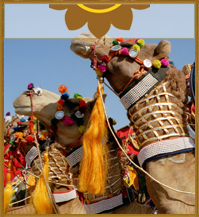
The Desert Festival is a colorful, joyous celebration of the rich heritage of Rajasthan. This festival takes place in Jaisalmer in the month of February and lasts for three days. During the desert festival, the sands around Jaisalmer are adorned with vibrant hues of music and dance, accompanied with sounds of laughter and joy. Musicians entice you with haunting ballads - a mixture of romantic verses weaved together with tunes of tragic pain. The fair has snake charmers, puppeteers, acrobats and folk performers. Camels also play a stellar role. This desert festival of India closes with an enchanting sound and light show amid the sand dunes on a moonlit night.
The preparations for this festival begins well in advance, where a few days before the spring full moon according to the Hindu calendar, musicians, dancers and performers from all over Rajasthan start moving in colorful camel caravans towards the golden town of Jaisalmer, which already begins to don a festive look. The 12th century fort of Jaisalmer, built in yellow sandstone, provides a fairytale background for this festival. It is a chance of a lifetime to see the folk art forms against the landscape that has nurtured them for hundreds of years.
Evenings are meant for the main shows of music and dance. Continuing till late into the night, the number of spectators increases by each night and on the final day, under the full moon night, the whole place is swarming with people who make it a point to be there to witness this mega show.

Maha Kumbh Mela
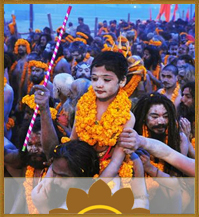
The biggest religious ceremony in the world, known as "Maha Kumbh Mela" (Great Festival of Urn), took place for the last time in this millennium in the northern Indian town of Hardwar on the banks of river Ganges. Here, millions of people had their ritual cleansing bath on eleven auspicious days from the beginning of January up to the end of April.
Hardwar is situated close to the spurs of the Shivaliks, the lowest range of the Himalayas. Hardwar means "Gate of God's Land". The link to paradise is established by the holy River Ganges. The Hindus call her Ganga after the river goddess. During the mela (festival) Hindus consider Hardwar as India's religious capital. Thousands of sadhus, gurus and their disciple as well as legions of pilgrims gathered there. More than ten million people – possibly twenty million, nobody could count them – dipped into the Ganga, in order to purify body, mind and soul and wash off their sins.
On the eve of such a bathing day, the town vibrates in hectic religious fever. In the courtyard of the railway station you can see many of India's myriad communities. Under open sky Gujaratis and Punjabis, Bengalis and Rajasthanis, Haryanvis and Tamils camp there, all identifiable by their costumes, turbans, hair styles and caste marks. The pilgrims sitting on blankets and mats chat, eat their chapatti bread and drink tea. The same picture you will find in the camps before the town gates where hundreds of thousands of believers sleep on the naked floor. Hardwar has no other choice but to accommodate such an immense crowd.

Trichur's Elephant Parade Kerala
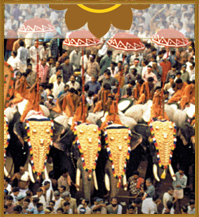
The great Elephant March-when a 101 gloriously bedecked elephants parade through the town of Trichur towards the village Cherpu. The event is viewed with awe and wonder by thousands of visitors from India and abroad.
The streets are choc-a-block with cars, jeeps and an assortment of cycles. I am unable to park my car till a kindly vendor clears a space for me by unceremoniously pushing a row of cycles against the wall. When I look doubtful, he grins broadly, "nobody will mind today." I thank him and park.
The air is thick with excitement. Little girls with scarlet ribbons and giant balloons hurry their parents along, while the sky fills with streamers. The rooftops of commercial buildings have been captured by young boys, while groups of giggling young girls holding their saris tightly join the crush of people flooding the vast Tekkinkadu maidan, surrounding the famous Vadakkunnathan Shiva temple at Trichur.
It is an extraordinary tourist happening, a three day extravaganza designed by the tourism wizards of Kerala, to be held every January.
The show opens at Trichur, or Tiru-Shiva-Perur which means the town that bears the name of Lord Shiva. Set amidst exquisite countryside, Trichur is a pretty mosaic of old fashioned cottages with sloping tiled roofs, tidy public structures, a string of shops and thatched sheds for cows.





